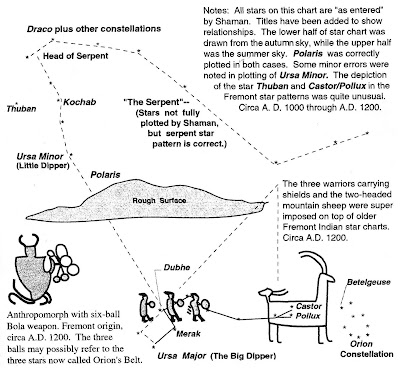Saturday, October 31, 2015
A COSMIC HOAX:
Station #16, Nine-Mile Canyon, UT.
Photograph Peter Faris, 1993.
Close-up of panel at Station
#16, Nine-Mile Canyon, UT.
Photograph Peter Faris, 1993.
In this column I am presenting another egregious mistake
from the book Odyssey of the Pueblo
Indians by William Eaton. On page 145 he presents a petroglyph panel that
he calls a "Pueblo (Fremont) Star Chart". That is his identification
of the well-known petroglyph panel from Station 16, in Nine-Mile Canyon, Utah.
One identification that I take exception to is what he calls
the two-headed mountain sheep. Upon careful examination of the petroglyph
Eaton's second head at the back of the animal is actually a conglomeration
composed of its tail and a couple of curved lines descending from an unknown
mark that has been destroyed by the impact of a large caliber bullet. The
remains of this mark can be seen circling around to the upper right of the bullet
crater.
On the left of this panel is a figure that Eaton calls an
"anthropomorph with a six-ball bola weapon." Now this is a very
interesting figure and does, in fact, remind one of a figure holding a bola. This
figure along with numbers of carefully rounded stone balls found at Fremont
sites have prompted this same identification by many other rock art
researchers. It is an interesting speculation, but one that has not been
proven. For some reason, and absolutely without any evidence at all Eaton has
claimed that "the three balls may possibly refer to the three stars now
called Orion's Belt." Which three balls Mr. Eaton? As you pointed out
there are six.
Then Eaton went on to identify the constellations Ursa
Major, Ursa Minor, and Serpens, as well as a few other stars including Polaris
in additional marks on the cliff face. Unfortunately, the majority of the stars
that Eaton identifies in this panel are, in reality, bullet holes put there by
Anglos much later than the petroglyphs. In many places, we find that
petroglyphs and pictographs provided seemingly irresistible targets to
gun-toting vandals. These unfortunate marks have never had anything to do with
Fremont or Pueblo Native American groups. Additionally, to make the constellation Serpens out of those bullet holes Eaton had to flip the constellation entirely as can be seen in the star chart below.
Star chart of the summer sky showing
Serpens to the left of center. From
Howard, The Telescope Handbook
and Star Atlas, 1967, p. 39.
This so-called "Pueblo (Fremont) Star Chart" is
just another mistaken example of someone who feels compelled to try to force
the facts to fit a theory that they bear no relation to in the real world.
While I applaud Mr. Eaton's enthusiasm, I do have to deplore his methods and
results.
REFERENCES:
Eaton, William M.
1999 Odyssey of the Pueblo Indians, Turner
Publishing Co., Paducah, KY.
Howard, Neale E.
1967 The Telescope Handbook and Star Atlas,
Thomas Y. Crowell Co., New York.
Labels:
9-Mile canyon,
constellation,
petroglyph,
rock art,
stars,
Utah
Subscribe to:
Post Comments (Atom)










No comments:
Post a Comment